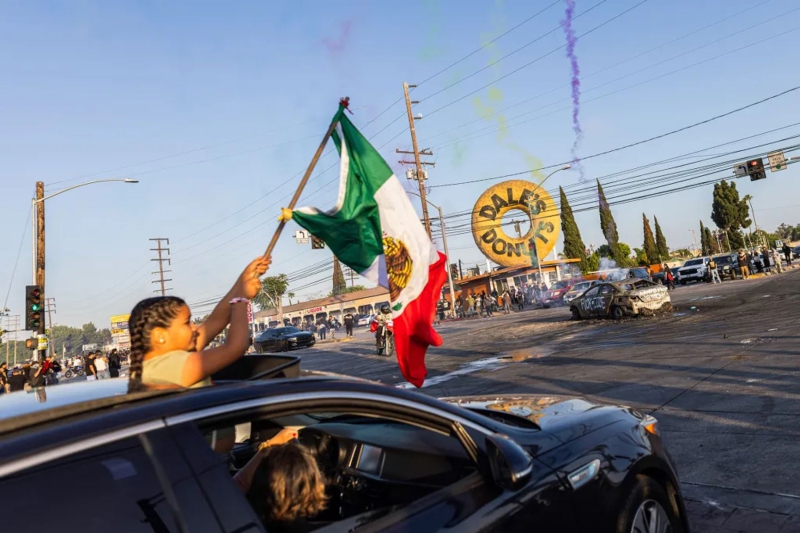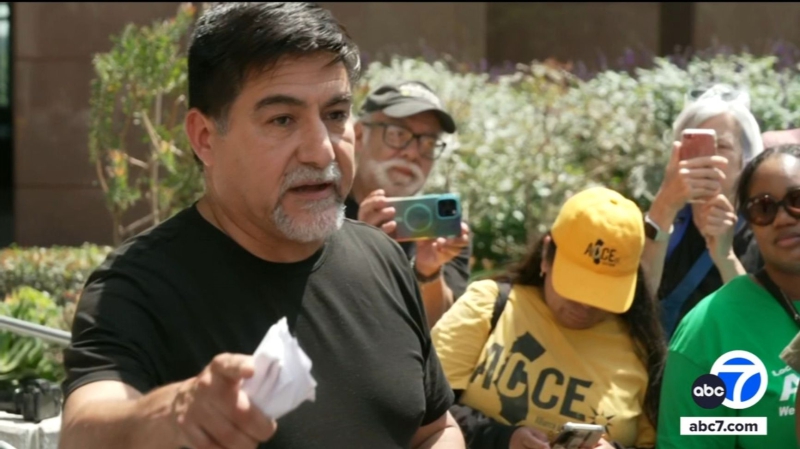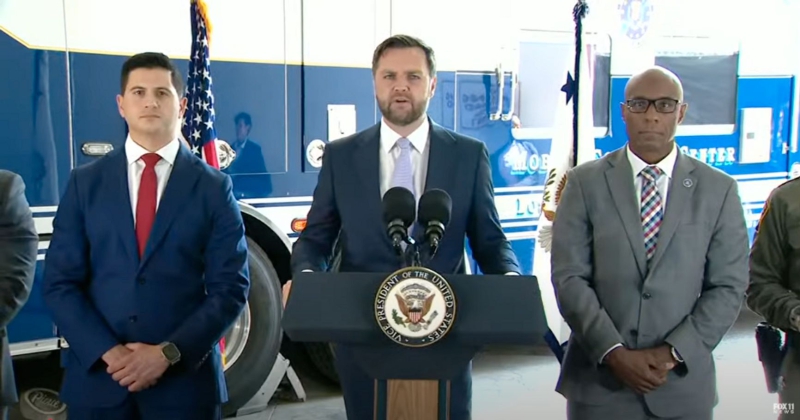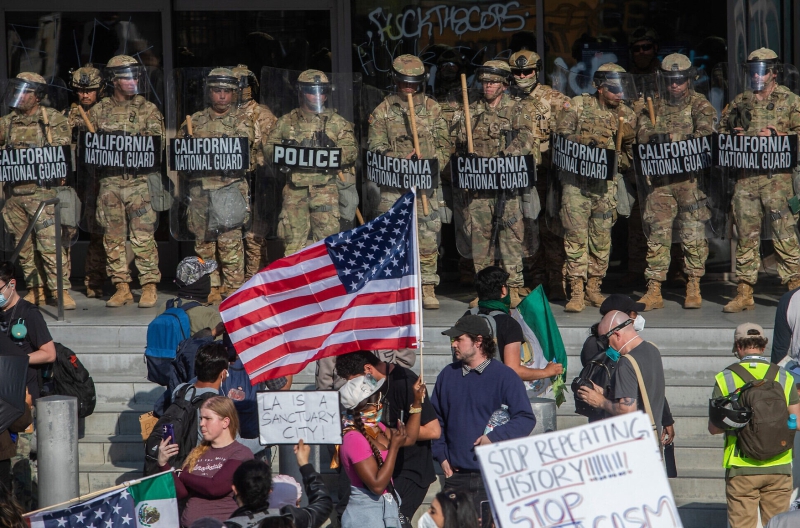Demonstrators stand opposite members of the California National Guard outside the Federal Building on June 9, 2025. Photo: Apu Gomes / AP
The thing I love most about Los Angeles is its multicultural liberalism. Every third resident is an immigrant, a dynamic that makes for a vibrant, constantly morphing community that blends its immense collection of diverse cultures, beliefs, and habits into something resembling unity. But it is a delicate balance, one that can be thrown off kilter easily, especially when a weighty outside force is applied.
That’s how, this past June, the City of Angeles found itself once again at the center of a national crisis. As federal immigration raids commenced, the city’s legacy of civil resistance was reawakened. Angelenos responded swiftly — gathering, marching, and, at times, clashing with law enforcement in defense of immigrant communities and sanctuary policies. In keeping with a history that includes the Watts Rebellion (1965), the East LA Walkouts (1968), the Rodney King Riots (1992), and the George Floyd protests (2020), the protests of June 2025 mark another chapter in the city's ongoing negotiation between civil liberties and federal authority.
June 6
Immigration and Customs Enforcement (ICE) initiates sweeping raids across Los Angeles. The Metropolitan Detention Center in Downtown becomes a flashpoint for demonstrations. Service Employees International Union (SEIU) President David Huerta is arrested for blocking a law enforcement vehicle. The Los Angeles Police Department (LAPD) declares an unlawful assembly and deploys tear gas and flash-bang grenades on protestors. A participant who declined to provide their name described the scene:
“I arrived in the middle of the action in Paramount around 5 p.m. This was when the mid-intersection car fire — very prominent in the news — was almost done burning. My understanding is that the Paramount events started as a peaceful protest. When I arrived, the crowd was being showered with tear gas, and there were lots of explosions. Some were flash-bangs; others were fireworks. It was chaos. Cops would advance, but very slowly. I got my first taste of tear gas, and it was nasty. I helped the crowd with basics like water.
Unfortunately, when I tried to intervene with some of the destructive and stupid acts that kids were doing, I actually got attacked a little by some of the rowdier kids in the crowd. There was a lot of shooting fireworks at the police. Gas station doors and windows were broken at some point. Some on the protester side were still trying to buy water from them. The guy who looked like a manager standing there appeared very upset. He looked Middle Eastern and was very likely an immigrant.
To me, the whole thing made little sense… I saw troublemaker kids who kept shooting dangerous fireworks at the cops. Some of the idiots were trying to set gas station pumps on fire. To be fair, I think at least one flash-bang was also — hopefully accidentally — thrown at the gas station. Luckily, the ARCO pumps withstood both of those tests.”

June 7
ICE raids expand into Panorama City. Demonstrations intensify, with protesters and law enforcement exchanging salvos of bricks and tear gas. Waymo robotaxis are set on fire and LAPD cruisers are pelted with rocks and concrete chunks — by protesters. In a dramatic escalation, President Trump overrides Governor Gavin Newsom’s authority by federalizing the National Guard and deploying the first troops to the city.
Another witness who preferred to remain unnamed explained:
“Someone said that if you stay away from federal buildings, there’ll be no tear gas and no flash-bangs, etc. And for a while, it was that way — but not for too long. Before you knew it, there were flash-bangs, fireworks, the crowd getting kettled, chaos all over. A lot of disappointing behavior. Those damn fireworks should not be shot at police. People kept setting Waymo cars on fire. Everything was devolving into dumb, pointless destruction. I saw public property destroyed, buildings vandalized — buildings and public property that had NOTHING to do with ICE. Some idiots were shooting fireworks at a tree near City Hall, trying to set it on fire. People were planning rallies here today, man!”

June 8
The California National Guard arrives. Protesters seize key areas of Downtown Los Angeles, including the steps of City Hall and a segment of U.S. Route 101. Incidents of looting and property damage are reported. Tensions escalate as LA Mayor Karen Bass, California Governor Newsom, and Trump himself engage in direct political confrontation. The federal government establishes Task Force 51 to coordinate the military response. That evening, the City of Glendale announces that it will terminate its cooperation agreement with ICE. LA resident Chris described the scene:
“I was smoking a cigarette outside in Glendale when a white van pulled over, and I got brutally manhandled by people in masks wearing khaki tactical gear without badges. Their primary inquiry was into my legal status, but when I showed U.S. citizen ID, they ticketed me for smoking. For the first time in my life, I got a ticket for smoking in LA Those masked people never introduced themselves properly, and it was clear they were ICE agents on a raid. It felt extremely disturbing and unsettling!”
June 9
Following demands from U.S. Senator from California Alex Padilla, David Huerta is released on a $50,000 bond. Demonstrations persist at Grand Park. In a controversial statement, President Trump suggests Governor Newsom should be arrested. The federal presence in the city expands, with 1,000 National Guard troops and an additional 700 U.S. Marines stationed in the area.

June 10
Mayor Bass declares a state of emergency and imposes a curfew in Downtown Los Angeles. Despite this, protests continue through the evening.
June 11
Authorities again declare an unlawful assembly. Law enforcement deploys batons and projectiles to disperse demonstrators. ICE raids extend to the city of Downey.
June 12
Senator Padilla is forcibly removed from a press conference held by Department of Homeland Security head Kristi Noem. Padilla is temporarily restrained face-down and handcuffed. Later that day, Federal Judge Charles Breyer declares the federalization of the National Guard to be unconstitutional and orders that control of the troops be returned to state authorities by noon on June 13.
June 13
The first recorded civilian arrest by U.S. Marines occurs. President Trump files an appeal to Judge Breyer’s ruling.
June 14
Massive “No Kings” and anti-ICE demonstrations erupt throughout Los Angeles and extend to the rest of the country — and to the wider world. LAPD responds with dispersal tactics, including tear gas and non-lethal munitions, near the Federal Building. Irena, a political activist, said:
“It was around 4:30 p.m. when I heard my first flash-bang grenade just about 20 yards away from me. I picked up my pace as we heard more bangs coming roughly from the block of City Hall. As we proceeded to the parking structure where I had parked, more and more shots or explosions of some sort followed from the area where authorities were definitely present but very few protesters remained — making us believe that the protesters were the ones under attack. It was about 4:45 p.m., a long time before the curfew to end the peaceful protests. Why were they trying to get us out?”
And a protester who preferred to remain anonymous added:
“When I was at the protests on June 14th in downtown LA, the LAPD had already started kettling people at 3:30 p.m., well before the curfew, which was at 8 p.m. Kettling is a crowd control method used to quell riots where the police officers block any exit point, but the protestors were unarmed civilians. What kettling does is that it prevents people who want to leave from leaving and it forces them to stay after curfew.”
June 17
Trump declares that troops are to stay in the City of Angels for up to 30 days under an emergency order.
June 20
Vice President JD Vance arrives in Los Angeles and speaks harshly about the incapacity of Mayor Bass and Governor Newsom to protect residents and property from civil unrest and lawless disorder. In an unfortunate turn of events, federal support for the victims of damage caused by recent straight-line winds and wildfires becomes a political bargaining chip as the standoff between Washington and local authorities escalates. LA resident Dayna described the situation:
“I actually found out about the protests when I was in DC, not in LA. I was on the street and the radio was playing from a store and mentioning things like, 'National Guard, Los Angeles, violence.' I looked up 'news on LA' and all these articles popped up. It was almost a movie moment — I very rarely get news from the radio anymore. When I was on the east coast, everyone was thinking LA was complete chaos. So when I landed, I was expecting to see everyone panicked and helicopters/police everywhere. I was surprised at how normal everything seemed and how calm people were, so I realized a lot of the protests were localized. And I know things have been terrible in those places, but I just noted it was interesting how the media was portraying things versus what was actually happening.”

The protests of June 2025 may presage a wider struggle between federal and state powers. In contrast to the George Floyd demonstrations, which were largely sparked by a singular act of violence, these protests were the result of a prolonged structural conflict. At its heart lies the clash between a conservative federal administration asserting control and a progressive state government resisting federal overreach.
With approximately 10% of Los Angeles County’s population being undocumented — despite many having longstanding ties to the community — the stakes are high. Critics question whether the federal government had fully considered the implications of initiating mass raids in a self-declared sanctuary jurisdiction. While claims of federal agents facing life-threatening danger at the Metropolitan Detention Center remain unverified, public scrutiny focused largely on the militarized nature of the federal government’s response.
Compared to previous civil disturbances in Los Angeles — most notably, the riots of 1992 — the June 2025 protests resulted in fewer injuries and less property damage. Although more than 40 individuals were injured, there were no reported fatalities. For many, this reflects a maturing protest culture, one that is more mindful of the impact its actions can have and the message they send to the wider country.
The temporary detention of Senator Padilla by federal officers drew particularly sharp criticism. Federal officials claimed they failed to identify him, purportedly because he was not wearing his Senators pin. In response, Padilla noted that if a sitting Senator could be subjected to such treatment, one could only imagine the dangers faced by migrant farmworkers. His statement struck a chord with many, prompting broader conversations about equality before the law.
Indeed, the events in and around Los Angeles prompted a deeper question: Why should treatment by authorities differ based on status? The protests were not simply a political reaction. They were, at their core, a societal reckoning with issues concerning privilege, justice, and representation.
In a recent development, federal judge Maame E. Frimpong ordered the Trump administration to stop indiscriminate immigration checks and arrests in seven California counties, including Los Angeles. The court also demanded that attorneys be granted access to a Los Angeles detention facility.
This ruling came as a response to a class action case against the federal government and immigration authorities. The Trump administration reacted immediately, declaring that immigration policies fall outside the purview of the judicial system — meaning this decision will be appealed.
The Department of Homeland Security reacted with a statement asserting “any claims that individuals have been ‘targeted’ by law enforcement because of their skin color are DISGUSTING and categorically FALSE.”
In the meantime, immigration authorities continue raiding sites with a potential high concentration of migrant workers — including a recent standoff at a cannabis farm, where ICE and other federal agents had to face protestors. One of the farmers remains in the ER unit in critical condition after falling from a 30-foot height amid the chaos of the raid. Agents had to use tear gas and other munitions.

